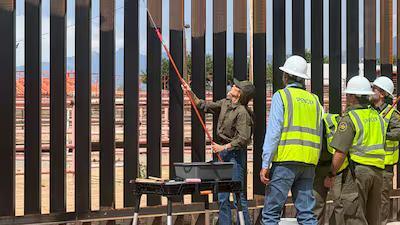
US-Mexico Border Wall Painted Black to Stop People from Climbing
In a bold move to curb illegal immigration into the United States, the country’s border wall with Mexico is set to receive a fresh coat of black paint. This innovative solution, confirmed by US Homeland Security Secretary Kristi Noem, aims to make it even more difficult for migrants to climb over the border fence.
The decision to paint the wall black is based on a simple yet effective principle: heat absorption. When the sun beats down on the wall, the black paint will absorb the heat, making it even warmer and more uncomfortable for would-be climbers. This added element of discomfort is expected to significantly reduce the number of attempts to scale the wall.
As Noem explained, “When something is painted black, it gets even warmer, making it even harder for people to climb.” This clever solution is expected to be a game-changer in the ongoing efforts to secure the US-Mexico border.
But the black paint is just one part of a larger plan to bolster border security. Additional cameras and sensors will also be installed along the wall to detect and deter any would-be border crossers. This integrated approach will provide a multi-layered defense system, making it even more challenging for individuals to breach the border.
The US-Mexico border wall has been a contentious issue for years, with both sides of the political spectrum holding strong opinions on its effectiveness and morality. However, the decision to paint the wall black is a pragmatic move that focuses on the practicalities of border security rather than ideology.
While some may argue that this approach is overly reliant on physical barriers, the fact remains that the US-Mexico border is one of the most porous in the world. A recent report by the Pew Research Center found that in 2019, an estimated 1.2 million unauthorized immigrants entered the US, with many using the southern border as their point of entry.
The black paint is not the only innovation being employed to secure the border. The US Customs and Border Protection (CBP) agency has also been testing the use of thermal imaging technology to detect heat signatures of would-be border crossers. This technology has proven to be highly effective in detecting individuals attempting to breach the border at night or in areas where visual surveillance is limited.
In addition to these technological advancements, the CBP is also investing in personnel and infrastructure to support its border security efforts. This includes the deployment of additional Border Patrol agents, the construction of new border facilities, and the upgrade of existing infrastructure to accommodate the growing number of migrants and asylum seekers.
The decision to paint the US-Mexico border wall black is just one part of a larger effort to modernize and strengthen border security. While it may not be a panacea for the complex issue of illegal immigration, it is a practical and effective solution that will undoubtedly make a significant impact on the number of attempts to breach the border.
As the US-Mexico border continues to be a pressing issue, it is crucial that policymakers and security officials work together to develop innovative solutions that balance security concerns with humanitarian needs. The black paint is just one example of how creativity and resourcefulness can be used to address the complex challenges facing the US-Mexico border.



